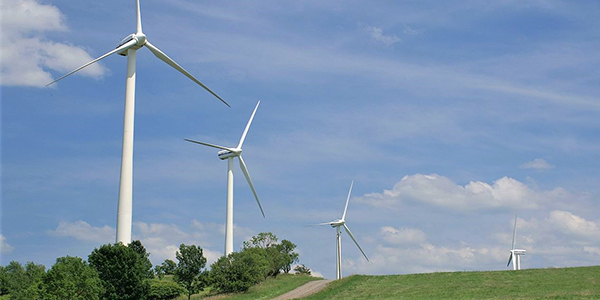Northland Power’s 100-MW High Bridge wind farm in central New York will move forward to construction following the completion of a three-year application and review process.
The New York Board on Electric Generation Siting and the Environment last week granted the Toronto-based company a certificate of environmental compatibility and public need for the project in Guilford, N.Y. (18-F-0262).
The wind farm, sited on about 4,000 acres of privately leased and purchased land, will have up to 25 wind turbines. It will connect with the bulk power system via a 17-mile transmission corridor and a substation with a proposed, 5-MW energy storage system.
During the application review process, the New York Department of Public Service (DPS) received about 180 public comments, most of which “opposed the project, focusing on environmental health and family impacts as well as impacts on community character,” DPS Administrative Law Judge Erika Bergen said during a Siting Board meeting Thursday.
Comments in support of the project cited the economic benefits to the local community as well as broad support of renewable energy development to combat climate change, she said.
The order granting the certificate includes terms of a settlement between Northland subsidiary High Bridge Wind, the town of Guilford, DPS staff and the New York departments of Environmental Conservation, Health, and Agriculture and Markets, Bergen said.
The settlement proposal names the Guildford Coalition of Non-participating Residents (GCNR) as a party, but the coalition chose not to sign the settlement. The group’s 200 members are not under contract with the developer or being paid considerations for property leases, easements or “good neighbor” agreements.
GCNR, in a statement Friday, said the state “took another step towards environmental disaster by approving the construction of [the wind farm] against the desires of the majority of the town’s nonparticipating residents.”
The coalition is considering filing a petition for rehearing with the siting board and a lawsuit in state or federal court.
“The majority of the nonparticipating residents and landowners in this case feel that the size and location of this facility is not responsible nor in the best interest of reasonable green energy initiatives,” Bill Pratt, GCNR founding partner, told NetZero Insider.
Procedural Irregularities
GCNR claimed that there were “irregularities” in the Siting Board’s proceedings, specifically stating that it failed to issue a recommended decision by the judges for public review and objection.
The board, however, is not required to issue a recommended decision, a DPS spokesperson told NetZero Insider.
A recommended decision “is used only where the examiners have questions that they would like additional input on before making a final recommendation to the Siting Board, but there were no such concerns here,” the spokesperson said, adding that “we have had several Siting Board determinations without [a recommended decision].”
GCNR also claimed that the board did not hold local public comment hearings required by statute “under the pretext of COVID.”
DPS, in line with guidelines concerning social distancing and considering executive orders that suspended provisions of the Open Meetings Law, has conducted its meetings remotely since last March, the DPS spokesperson said.
Intervenor Funding
GNCR claimed that the Siting Board approved an “unfair distribution of funding to a town government that was supportive of the project.”
The final order awarded $82,787 to Guilford and $35,000 to GCNR.
In a request to reconsider the distribution, GCNR said that the award was unfair because the town received more than half of the available funds, while its position on the project was inconsistent with 70% of the town’s residents. The board denied the request on the grounds that GCNR had not demonstrated that 70% of residents opposed the project, according to the final order.
The board determined that the distribution was fair because the town represented the interests of every resident, whereas GCNR represented only the interests of its membership, which was small (200) in relation to the population of the town (2,922 in 2010).
Noise Impacts
During the application proceedings, GCNR asked the Siting Board to apply wind turbine sound level standards to the project that it said were adopted by the World Health Organization (WHO) in 2018. The board said in its order that WHO only made a “conditional recommendation” for wind turbine sound levels and that it rejected them because they rely on “low quality data.”
“Sound levels proposed by the settling parties are the same noise limits that we consistently have deemed appropriate to be protective of health and minimize potential annoyance for other recently approved projects,” the order said. The board plans to apply those standards to future projects, unless new evidence suggests the approach is not adequate, it said.
The standards are 45 A-weighted decibels equivalent sound level (dBA Leq) over eight hours at nonparticipating residences and 55 dBA Leq at participating residences. WHO recommends, for average noise exposure, reducing wind turbine noise below 45 dBA Leq over a whole day, with an additional 10-dBA reduction for nighttime hours and 5-dBA reduction in evening hours.


